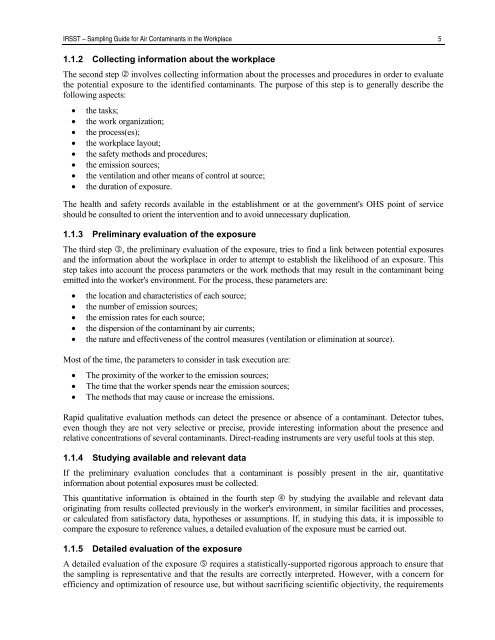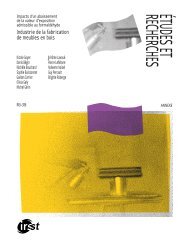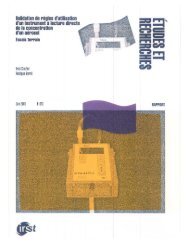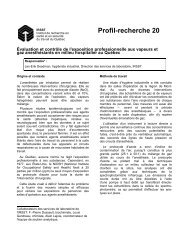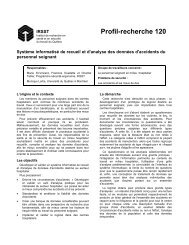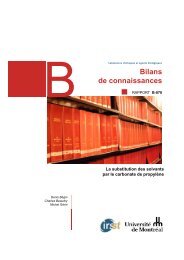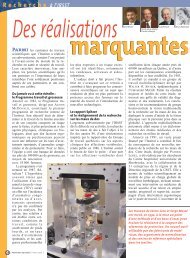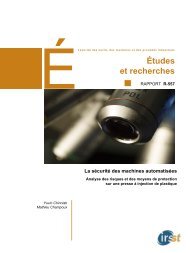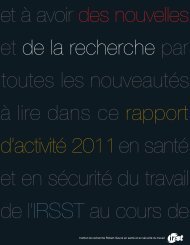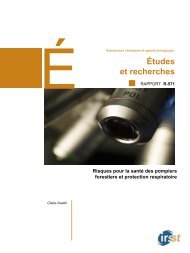Sampling Guide for Air Contaminants in the Workplace - Irsst
Sampling Guide for Air Contaminants in the Workplace - Irsst
Sampling Guide for Air Contaminants in the Workplace - Irsst
You also want an ePaper? Increase the reach of your titles
YUMPU automatically turns print PDFs into web optimized ePapers that Google loves.
IRSST – <strong>Sampl<strong>in</strong>g</strong> <strong>Guide</strong> <strong>for</strong> <strong>Air</strong> <strong>Contam<strong>in</strong>ants</strong> <strong>in</strong> <strong>the</strong> <strong>Workplace</strong> 5<br />
1.1.2 Collect<strong>in</strong>g <strong>in</strong><strong>for</strong>mation about <strong>the</strong> workplace<br />
The second step <strong>in</strong>volves collect<strong>in</strong>g <strong>in</strong><strong>for</strong>mation about <strong>the</strong> processes and procedures <strong>in</strong> order to evaluate<br />
<strong>the</strong> potential exposure to <strong>the</strong> identified contam<strong>in</strong>ants. The purpose of this step is to generally describe <strong>the</strong><br />
follow<strong>in</strong>g aspects:<br />
• <strong>the</strong> tasks;<br />
• <strong>the</strong> work organization;<br />
• <strong>the</strong> process(es);<br />
• <strong>the</strong> workplace layout;<br />
• <strong>the</strong> safety methods and procedures;<br />
• <strong>the</strong> emission sources;<br />
• <strong>the</strong> ventilation and o<strong>the</strong>r means of control at source;<br />
• <strong>the</strong> duration of exposure.<br />
The health and safety records available <strong>in</strong> <strong>the</strong> establishment or at <strong>the</strong> government's OHS po<strong>in</strong>t of service<br />
should be consulted to orient <strong>the</strong> <strong>in</strong>tervention and to avoid unnecessary duplication.<br />
1.1.3 Prelim<strong>in</strong>ary evaluation of <strong>the</strong> exposure<br />
The third step , <strong>the</strong> prelim<strong>in</strong>ary evaluation of <strong>the</strong> exposure, tries to f<strong>in</strong>d a l<strong>in</strong>k between potential exposures<br />
and <strong>the</strong> <strong>in</strong><strong>for</strong>mation about <strong>the</strong> workplace <strong>in</strong> order to attempt to establish <strong>the</strong> likelihood of an exposure. This<br />
step takes <strong>in</strong>to account <strong>the</strong> process parameters or <strong>the</strong> work methods that may result <strong>in</strong> <strong>the</strong> contam<strong>in</strong>ant be<strong>in</strong>g<br />
emitted <strong>in</strong>to <strong>the</strong> worker's environment. For <strong>the</strong> process, <strong>the</strong>se parameters are:<br />
• <strong>the</strong> location and characteristics of each source;<br />
• <strong>the</strong> number of emission sources;<br />
• <strong>the</strong> emission rates <strong>for</strong> each source;<br />
• <strong>the</strong> dispersion of <strong>the</strong> contam<strong>in</strong>ant by air currents;<br />
• <strong>the</strong> nature and effectiveness of <strong>the</strong> control measures (ventilation or elim<strong>in</strong>ation at source).<br />
Most of <strong>the</strong> time, <strong>the</strong> parameters to consider <strong>in</strong> task execution are:<br />
• The proximity of <strong>the</strong> worker to <strong>the</strong> emission sources;<br />
• The time that <strong>the</strong> worker spends near <strong>the</strong> emission sources;<br />
• The methods that may cause or <strong>in</strong>crease <strong>the</strong> emissions.<br />
Rapid qualitative evaluation methods can detect <strong>the</strong> presence or absence of a contam<strong>in</strong>ant. Detector tubes,<br />
even though <strong>the</strong>y are not very selective or precise, provide <strong>in</strong>terest<strong>in</strong>g <strong>in</strong><strong>for</strong>mation about <strong>the</strong> presence and<br />
relative concentrations of several contam<strong>in</strong>ants. Direct-read<strong>in</strong>g <strong>in</strong>struments are very useful tools at this step.<br />
1.1.4 Study<strong>in</strong>g available and relevant data<br />
If <strong>the</strong> prelim<strong>in</strong>ary evaluation concludes that a contam<strong>in</strong>ant is possibly present <strong>in</strong> <strong>the</strong> air, quantitative<br />
<strong>in</strong><strong>for</strong>mation about potential exposures must be collected.<br />
This quantitative <strong>in</strong><strong>for</strong>mation is obta<strong>in</strong>ed <strong>in</strong> <strong>the</strong> fourth step by study<strong>in</strong>g <strong>the</strong> available and relevant data<br />
orig<strong>in</strong>at<strong>in</strong>g from results collected previously <strong>in</strong> <strong>the</strong> worker's environment, <strong>in</strong> similar facilities and processes,<br />
or calculated from satisfactory data, hypo<strong>the</strong>ses or assumptions. If, <strong>in</strong> study<strong>in</strong>g this data, it is impossible to<br />
compare <strong>the</strong> exposure to reference values, a detailed evaluation of <strong>the</strong> exposure must be carried out.<br />
1.1.5 Detailed evaluation of <strong>the</strong> exposure<br />
A detailed evaluation of <strong>the</strong> exposure requires a statistically-supported rigorous approach to ensure that<br />
<strong>the</strong> sampl<strong>in</strong>g is representative and that <strong>the</strong> results are correctly <strong>in</strong>terpreted. However, with a concern <strong>for</strong><br />
efficiency and optimization of resource use, but without sacrific<strong>in</strong>g scientific objectivity, <strong>the</strong> requirements


